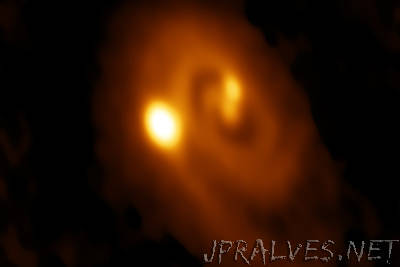
“Did our Sun have a twin when it was born 4.5 billion years ago? Almost certainly yes — though not an identical twin. And so did every other Sun-like star in the universe, according to a new analysis by a theoretical physicist from the University of California, Berkeley, and a radio astronomer from the Smithsonian Astrophysical Observatory at Harvard University. Many stars have companions, including our nearest neighbor, Alpha Centauri, a triplet system. Astronomers have long sought an explanation. Are binary and triplet star systems born that way? Did one star capture another? Do binary stars sometimes split up and become single stars? Astronomers have even searched for a companion to our Sun, a star dubbed Nemesis because it was supposed to have kicked an asteroid into Earth’s orbit that collided with our planet and exterminated the dinosaurs. It has never been found. The new assertion is based on a radio survey of a giant molecular cloud filled with recently formed stars in the constellation Perseus, and a mathematical model that can explain the Perseus observations only if all Sun-like stars are born with a companion. “We are saying, yes, there probably was a Nemesis, a long time ago,” said co-author Steven Stahler, a UC Berkeley research astronomer. “We ran a series of statistical models to see if we could account for the relative populations of young single stars and binaries of all separations in the Perseus molecular cloud, and the only model that could reproduce the data was one in which all stars form initially as wide binaries. These systems then either shrink or break apart within a million years.” In this study, “wide” means that the two stars are separated by more than 500 astronomical units, or AU, where one astronomical unit is the average distance between the Sun and Earth (93 million miles). A wide binary companion to our Sun would have been 17 times farther from the Sun than its most distant planet today, Neptune. Based on this model, the Sun’s sibling most likely escaped and mixed with all the other stars in our region of the Milky Way galaxy, never to be seen again. “The idea that many stars form with a companion has been suggested before, but the question is: how many?” said first author Sarah Sadavoy, a NASA Hubble fellow at the Smithsonian Astrophysical Observatory. “Based on our simple model, we say that nearly all stars form with a companion. The Perseus cloud is generally considered a typical low-mass star-forming region, but our model needs to be checked in other clouds.” The idea that all stars are born in a litter has implications beyond star formation, including the very origins of galaxies, Stahler said. Stahler and Sadavoy posted their findings in April on the arXiv and is available online. Their paper has been accepted for publication in the Monthly Notices of the Royal Astronomical Society.”
